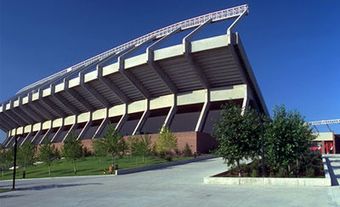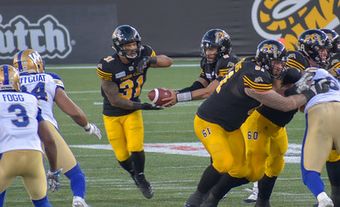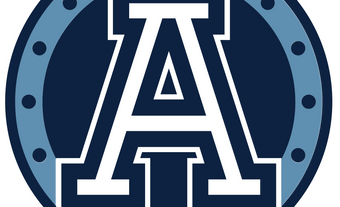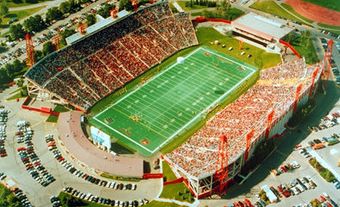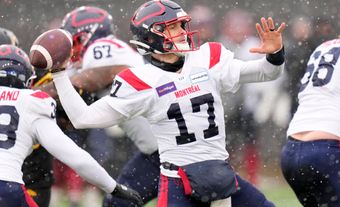The Winnipeg Blue Bombers are a football team in the Canadian Football League (CFL). Located in Winnipeg, Manitoba, the Blue Bombers have alternated between the league’s West Division and East Division. They have been part of the West Division since 2014. Since its founding in 1930, the team has won 12 Grey Cup championships. In 2019, the team won its first Grey Cup since 1990 when it defeated the Hamilton Tiger-Cats 33–12. After the 2020 season was cancelled due to the COVID-19 pandemic, the Blue Bombers defeated Hamilton in the 2021 Grey Cup by a score of 33–25. It marked the team’s first back-to-back championship since 1962, and the first in the CFL since the Montreal Alouettes in 2010. From 2022 to 2024, the Bombers made three consecutive Grey Cup appearances, though they lost each time.

| Quick Facts about the Winnipeg Blue Bombers |
| Date Founded: 1930 |
| Venue: Investors Group Field |
| Team Colours: Royal Blue, Metallic Gold |
| Grey Cup Victories: 12 |
Early History of Football in Winnipeg
Several amateur rugby football clubs, originally playing under English rugby rules, competed in Winnipeg as early as the 1880s. In 1888, the Winnipeg Rugby Football Club, the St. John’s College team and the Royal School of Mounted Infantry team formed the Manitoba Rugby League. By 1890, a team called the Winnipeg Football Club was playing games against a team from Regina, Saskatchewan, establishing a rivalry between the two cities and provinces that continues to the present day.
The Manitoba Rugby Football Union was formed in 1892, followed in 1911 by the Western Canada Rugby Football Union (WCRFU) consisting of teams from Manitoba, Saskatchewan and Alberta. The first Winnipeg team to become WCRFU champion was the Winnipeg Victorias, in 1924. From 1913 to 1929, another Winnipeg team, the Tammany Tigers, also played in the WCRFU; the Tigers made it to the Grey Cup in 1925, but lost to the Ottawa Senators 24–1.
The Winnipeg Rugby Football Club (‘Pegs or Winnipegs)
The Winnipeg Rugby Football Club, the precursor to today’s Winnipeg Blue Bombers, was founded in June 1930. Popularly known as the Winnipegs or simply the ‘Pegs, the club was an amalgamation of the Tammany Tigers and other Winnipeg teams, and was a member of the WCRFU. Their first game, a loss, was played against the St. John’s Rugby Football Club, also based in Winnipeg. These two teams further amalgamated in 1933, forming one stronger team under the Winnipeg Football Club (or ‘Pegs/Winnipegs) name, and wearing today’s blue and gold jersey colours. The merger meant a lack of local competition, a problem the new team solved by organizing exhibition games against American university teams in neighbouring Minnesota and North Dakota, with one half-game of football played under Canadian rules and the next half-game under US rules. This innovative solution continued through 1935.
The year 1935 saw football in Winnipeg becoming firmly established, with an influx of American players, and the ‘Pegs victory in the Grey Cup final. Frustrated by the long dominance of the Grey Cup by eastern teams, the ‘Pegs administration hired a number of American import (now called international) players, taking advantage of the contacts they had made while playing exhibition games in the US and offering financial incentives to nine American players, including Fritz Hanson. Although American players had been recruited by teams before, Winnipeg was the first to import a large contingent. These hirings were controversial and eventually led to present-day rules governing player imports.
As a result of their bold manoeuvre, the ‘Pegs became the first western team to win the Grey Cup. The 1935 championship game was played in Hamilton against the Hamilton Tigers, with the ‘Pegs victorious 18–12. Fritz Hanson was the star of the game, especially on kick returns, setting a record with 300 punt-return yards. Quarterback Russ Rebholz also threw two touchdown passes. The 1935 Grey Cup game was also the first to be broadcast nationally on radio.
Winnipeg Blue Bombers (1936–49)
Following the historic 1935 win, the game of football, and Canada’s eastern and western football leagues, continued to evolve. In 1936, the Western Interprovincial Football Union (WIFU) was formed, comprising teams from Winnipeg, Regina and Calgary. The same year, the ‘Pegs became known as the Winnipeg Blue Bombers, the name the team is known by today. This nickname was created by a Winnipeg Tribune reporter in reference to American boxer Joe Louis, who was known as the “Brown Bomber.”
The new Winnipeg Blue Bombers team under coach Bob Fritz led the 1936 season with five wins, one tie and two losses. The WIFU semi-final was played over a two-game series against Regina, with Regina winning 24–12. The next year the Bombers team played to a 4–4 record, enough to win the WIFU two-game final against Calgary. This took them to the Grey Cup, which they lost to Toronto 4–3 in an unusually low-scoring game.
By 1939, the season was 12 games long, and Winnipeg won the WIFU title again under coach Reg Threlfall. They earned their second Grey Cup later that season.
Winnipeg played eight-game seasons in 1940 and 1941, winning the WIFU title both years and a third Grey Cup in 1941. From 1942 to 1945, the WIFU suspended regular-season play due to the war, but many Blue Bombers found playing opportunities on the similarly named Winnipeg RCAF Bombers team, which contested the Grey Cup in 1942 and 1943. In 1945, the Blue Bombers returned to the Grey Cup, but were shut out by the Toronto Argonauts 35–0. They reached the finals in 1946 and 1947 as well, losing to Toronto both times.
The Mud Bowl: Grey Cup 1950
The 1950s started strong under coach Frank Larson, with the team posting a 10–4 record and winning the 1950 division title. Quarterback Jack Jacobs led the team to yet another Grey Cup game, one that went down in history as “The Mud Bowl.” Heavy rain and the lack of covering for Toronto’s Varsity Stadium field created conditions reminiscent of First World War battlefields, with the playing field a puddle-filled quagmire. Yard markings and jersey numbers became totally obscured by mud; the balls became waterlogged, and Winnipeg completed only three passes and three first downs. At one point, Winnipeg lineman Buddy Tinsley was injured and lay facedown on the field. Legend has it that he almost drowned. The final score was Toronto 13, Winnipeg 0 (this was the last time any team was shut out in the Grey Cup game).
Winnipeg Blue Bombers 1950–62
From 1950 to 1962, the Blue Bombers reached the Grey Cup game seven times, winning four (1958, 1959, 1961 and 1962). Following their loss to Toronto in the 1950 Mud Bowl, it would be several years before the team returned to the Grey Cup final. In 1953, Winnipeg faced Hamilton in the final, losing 12–6. The same year, the team moved to the new Winnipeg Stadium (later renamed Canad Inns Stadium), with a capacity of 29,530 fans.
Four years later, the Blue Bombers again faced the Hamilton Tiger-Cats. Like the 1950 Mud Bowl, the 1957 Grey Cup game was historic, as it was the first final to be televised coast to coast. It also became infamous, when a fan interfered with the result by tripping a Hamilton player who had intercepted the ball and was racing for the Winnipeg end zone. Despite this intervention, Winnipeg still lost, 32–7.
The period 1958 to 1962 saw not only the establishment of the Canadian Football League (CFL), but also the Winnipeg club’s second dynasty period, in which it won the West Division final six times under Bud Grant, who was the team’s longest-serving head coach (1957 to 1966 seasons).
Under Grant, the Blue Bombers won four Grey Cups. In 1958 and 1959, they defeated the Hamilton Tiger-Cats to win Canadian football’s top prize. In 1960, the Blue Bombers’ regular season record was a successful 14–2, but they lost to the Edmonton Eskimos in the Western Finals. The following year, the team defeated Hamilton in the first Grey Cup overtime game, 21–14; the overtime period featured a touchdown running play by quarterback Ken Ploen. The entire 1961 team was later inducted into the Manitoba Sports Hall of Fame.
The Fog Bowl: Grey Cup 1962
Further excitement followed with Winnipeg and Hamilton meeting again in the Grey Cup on 1 December 1962 in Toronto. An unprecedented dense pea-soup fog rolled in from Lake Ontario for the second quarter, severely reducing visibility to a few feet above ground; quarterbacks could not see their receivers, receivers and punt returners couldn’t see the ball, and officials, fans and television viewers couldn’t see the action. Officials finally suspended play with 9 minutes 29 seconds left and Winnipeg leading 28–27; play was resumed the next day under a clear sky, and with no further scoring, Winnipeg was victorious. This historic game, the only two-day Grey Cup contest, is today known as “The Fog Bowl.”
Winnipeg Blue Bombers 1963–80
The team struggled in the wake of its 1962 Grey Cup victory, however, with a losing season in 1963 (seven wins, nine losses) followed by a 13-game losing streak in 1964, from August to November. Although the Blue Bombers made it to the Grey Cup in 1965, they lost the match to the Tiger-Cats, and for the next 18 years (1966–83), the team failed to advance to the Grey Cup.
In the early 1970s, the Blue Bombers began a partial recovery from their slump under quarterback Don Jonas, who was their leading scorer in 1971 and was voted the CFL’s outstanding player of the year. With coach Jim Spavital, the team won the 1972 West Division championship with a regular-season record of 10 wins and six losses, but lost to the Saskatchewan Roughriders in the division playoff final. The Blue Bombers did not win their division in the regular season for the rest of the decade, finishing dead last in 1973 and fourth in 1974. From 1975 to 1978, though, the team made it to the semi-finals. Stars of this decade included kicker Bernie Ruoff, running backs Mack Herron and Dave Raimey, receiver Joe Poplawski and quarterback Dieter Brock, who joined the team in 1974.
Winnipeg Blue Bombers in the 1980s
Head coach Cal Murphy (1983–87), later the team’s general manager, was an instrumental figure for the Blue Bombers through the 1980s, with the team posting reassuring results. Winnipeg enjoyed a long string of appearances in playoff games from 1980 to 1996. They finished second in their division for six consecutive years (1980 to 1985), and from October 1983 to October 1985 fans cheered a 16-game winning streak at home. In 1984, the team again tasted victory, beating the powerhouse BC Lions in the West final, and then the Hamilton Tiger-Cats in the Grey Cup, 47–17. Quarterback Tom Clements and linebacker Tyrone Jones were named the game’s most valuable players.
In 1987, after the Montreal Alouettes club folded, the CFL placed the Bombers in the East Division to balance the divisions with four teams each. Although the realignment went against natural regional alliances and was unpopular, it resulted in East Division titles for Winnipeg in 1988 and 1990 under coach Mike Reilly. Stars of the era included Willard Reaves, Chris Walby, Trevor Kennerd and Joe Poplawski.
The Bombers began their 1988 season with a 5–6 record, but won seven of their last 10 games to finish second in the East Division. After winning the East final, they took on the BC Lions to claim the Grey Cup in a close 22–21 victory, the first Grey Cup game played by two teams from western Canada.
Winnipeg Blue Bombers in the 1990s
The decade began with another East Division championship for the Blue Bombers and the 1990 Grey Cup victory, in which the Bombers punished the Edmonton Eskimos 50–11. The most valuable player award was split between quarterback Tom Burgess and linebacker Greg Battle. With this game, the Bombers team (including the wartime Winnipeg RCAF Bombers) proudly established a record for the most Grey Cup appearances (21) from 1935 to 1990.
Highlights of the next year included the 19 October 1991 game in which Winnipeg scored 68 points against Hamilton (68–14), one of the highest-scoring football games in league history. On 24 November 1991, Winnipeg hosted its first Grey Cup game with 51,985 fans attending, although the Bombers themselves did not participate in the game.
The next three years saw continued football excitement for Winnipeg fans, with consecutive East Division titles 1992 to 1994, and Grey Cup appearances in 1992 and 1993. On 14 July 1994, quarterback Matt Dunigan set a one-game passing record of 713 yards. During this period, the team’s leading scorer was Troy Westwood, and leading rushers were Robert Mimbs and Mike Richardson.
In 1995 the team gained record-setting star receiver and eventual hall-of-famer Milt Stegall, but nevertheless won only seven games. The next year the team found itself again briefly in the West Division, but yo-yoed back to the East Division by 1997 when the Ottawa Rough Riders shut down operations.
The Blue Bombers had a tough year in 1998, with 10 consecutive losses to start the season, and a fourth place finish. Winnipeg hosted its second Grey Cup game, but again did not play in it. The following year, quarterback Khari Jones joined the club and formed a formidable partnership with receiver Milt Stegall.
Winnipeg Blue Bombers 2000–10
Winnipeg’s fortunes improved in 2001, with a 12-game winning streak from August to October that brought them the East Division title. However, the team was defeated in the Grey Cup game by the Calgary Stampeders.
With the arrival of the new Ottawa Renegades team in the East Division in 2002, Winnipeg returned to the West Division, finishing second. Troy Westwood was again the team’s leading scorer from 2002 to 2003.
In 2004, a new Labour Day-game tradition, the Banjo Bowl, began. Played annually between the Winnipeg Blue Bombers and Saskatchewan Roughriders, the Banjo Bowl alternates between Regina and Winnipeg. The game got its name from a comment made by Troy Westwood, who referred to Saskatchewan fans as “a bunch of banjo-pickin’ inbreds,” reflecting the long-standing football rivalry between the neighbouring provinces.
When the Ottawa Renegades suspended operations in 2006, the Blue Bombers were moved yet again to the East Division. The following year the Blue Bombers finished second in the East and defeated the Toronto Argonauts in the division final. Their Grey Cup hopes were dashed, however, when quarterback Kevin Glenn broke his arm in that game and Winnipeg was forced to start a rookie quarterback in the Grey Cup game the following week against their historic rivals, the Saskatchewan Roughriders. The Roughriders prevailed 23–19.
In 2008, the Blue Bombers made it to the semi-finals but lost, and coach Doug Berry was dismissed, the first in a string of coach firings. Coach Mike Kelly was let go after the 2009 season.
Charles Roberts (2003–07) and Fred Reid (2007–11) were the team’s leading rushers in this decade. In 2008, receiver Milt Stegall retired after 14 years with Winnipeg; he had played 199 games, earned ten 1,000-yard seasons and made 144 touchdowns.
Winnipeg Blue Bombers 2010–Present
Although the Bombers ended their 2010 season with only four wins and a fourth-place finish in the East, the team’s fortunes temporarily improved under coach Paul LaPolice. In 2011, the team went 10–8 and secured first place in the East Division, largely due to its strong defence, and to the efforts of players such as quarterback Buck Pierce. The Eastern final was played at home against the Hamilton Tiger-Cats, who scored only three points, all in the first quarter; Winnipeg held them to zero points for the remainder of the game, winning 19–3. However, Winnipeg’s luck did not hold for the following week’s Grey Cup game, which they lost to the BC Lions 34–23.
The team struggled through 2012, beginning a period of four years in which the Blue Bombers failed to make it to the playoffs (2012–15). Coach LaPolice was fired mid-season in 2012, with Mike O’Shea taking over the following year. After the Ottawa RedBlacks joined the league in 2014, the Bombers found themselves back in the West Division, where they finished last. The team began to spark once again by 2016, winning seven games in a row mid-season and finishing the regular season with an 11–7 record in third place. However, they narrowly lost the West semi-final to the BC Lions 32–31.
In 2019, the team won its first Grey Cup since 1990 when it defeated the Hamilton Tiger-Cats 33–12. After the 2020 season was cancelled due to the COVID-19 pandemic, the Blue Bombers defeated Hamilton in the 2021 Grey Cup by a score of 33–25. It marked the team’s first back-to-back championship since 1962, and the first in the CFL since the Montreal Alouettes in 2010. From 2022 to 2024, the Bombers made three consecutive Grey Cup appearances, though they lost each time.
Winnipeg Blue Bombers in the Grey Cup
| Year | Won | Lost | Host City |
| 1935 | Winnipeg ‘Pegs 18 | Hamilton Tigers 12 | Hamilton |
| 1937 | Toronto Argonauts 4 | Winnipeg Blue Bombers 3 | Toronto |
| 1938 | Toronto Argonauts 30 | Winnipeg Blue Bombers 7 | Toronto |
| 1939 | Winnipeg Blue Bombers 8 | Ottawa Rough Riders 7 | Ottawa |
| 1941 | Winnipeg Blue Bombers 18 | Ottawa Rough Riders 16 | Toronto |
| 1942 | Toronto RCAF Hurricanes 8 | Winnipeg RCAF Bombers 5 | Toronto |
| 1943 | Hamilton Flying Wildcats 23 | Winnipeg RCAF Bombers 14 | Toronto |
| 1945 | Toronto Argonauts 35 | Winnipeg Blue Bombers 0 | Toronto |
| 1946 | Toronto Argonauts 28 | Winnipeg Blue Bombers 6 | Toronto |
| 1947 | Toronto Argonauts 10 | Winnipeg Blue Bombers 9 | Toronto |
| 1950 | Toronto Argonauts 13 | Winnipeg Blue Bombers 0 | Toronto |
| 1953 | Hamilton Tiger-Cats 12 | Winnipeg Blue Bombers 6 | Toronto |
| 1957 | Hamilton Tiger Cats 32 | Winnipeg Blue Bombers 7 | Toronto |
| 1958 | Winnipeg Blue Bombers 35 | Hamilton Tiger-Cats 28 | Vancouver |
| 1959 | Winnipeg Blue Bombers 21 | Hamilton Tiger-Cats 7 | Toronto |
| 1961 | Winnipeg Blue Bombers 21 | Hamilton Tiger-Cats 14 | Toronto |
| 1962 | Winnipeg Blue Bombers 28 | Hamilton Tiger-Cats 27 | Toronto |
| 1965 | Hamilton Tiger-Cats 22 | Winnipeg Blue Bombers 16 | Toronto |
| 1984 | Winnipeg Blue Bombers 47 | Hamilton Tiger-Cats 17 | Edmonton |
| 1988 | Winnipeg Blue Bombers 22 | BC Lions 21 | Ottawa |
| 1990 | Winnipeg Blue Bombers 50 | Edmonton Eskimos 11 | Vancouver |
| 1992 | Calgary Stampeders 24 | Winnipeg Blue Bombers 10 | Toronto |
| 1993 | Edmonton Eskimos 33 | Winnipeg Blue Bombers 23 | Calgary |
| 2001 | Calgary Stampeders 27 | Winnipeg Blue Bombers 19 | Montréal |
| 2007 | Saskatchewan Roughriders 23 | Winnipeg Blue Bombers 19 | Toronto |
| 2011 | BC Lions 34 | Winnipeg Blue Bombers 23 | Vancouver |
| 2019 | Winnipeg Blue Bombers 33 | Hamilton Tiger-Cats 12 | Calgary |
| 2020 | Season cancelled | ||
| 2021 | Winnipeg Blue Bombers 33 | Hamilton Tiger-Cats 25 | Hamilton |
| 2022 | Toronto Argonauts 24 | Winnipeg Blue Bombers 23 | Regina |
| 2023 | Montreal Alouettes 28 | Winnipeg Blue Bombers 24 | Hamilton |
| 2024 | Toronto Argonauts 41 | Winnipeg Blue Bombers 24 | Vancouver |
Winnipeg Blue Bombers in Canadian Football Hall of Fame
| Name | Position | Year Inducted |
| Greg Battle | linebacker | 2007 |
| Paul Bennett | defensive back | 2002 |
| John Bonk | linebacker, centre | 2008 |
| Dieter Brock | quarterback | 1995 |
| Doug Brown | defensive tackle | 2016 |
| Less Browne | defensive back | 2002 |
| Paul Brule | running back, punt returner | 2018 |
| Bob Cameron | punter | 2010 |
| Tom Casey | running back/defensive back/punter | 1964 |
| Tom Clements | quarterback | 1994 |
| Carl Cronin | halfback/linebacker | 1967 |
| Weston Dressler | receiver | 2024 |
| Matt Dunigan | quarterback | 2006 |
| Bill Frank | offensive tackle | 2001 |
| Tommy Grant | wide receiver/defensive back | 1995 |
| Herb Gray | defensive end/guard | 1983 |
| Melvin “Fritz” Hanson | halfback, punt returner | 1963 |
| John Helton | defensive tackle/defensive end | 1986 |
| Dick Huffman | offensive tackle/defensive tackle | 1987 |
| Jack Jacobs | quarterback | 1963 |
| Eddie James | halfback | 1963 |
| Harvey “Tyrone” Jones | linebacker | 2012 |
| Ray Jauch | coach | 2024 |
| Greg Kabat | quarterback/guard | 1966 |
| Les Lear | guard | 1974 |
| Leo Lewis | running back | 1973 |
| Ches McCance | end/kicker | 1976 |
| Danny McManus | quarterback | 2011 |
| James Murphy | wide receiver | 2000 |
| Ernie Pitts | receiver/defensive back | 2019 |
| Ken Ploen | quarterback/defensive back | 1975 |
| Joe Poplawski | wide receiver | 1998 |
| Dave Raimey | running back | 2000 |
| Russ Rebholz | quarterback/halfback/kicker | 1963 |
| Frank Rigney | offensive tackle | 1985 |
| Dave Ritchie | coach | 2022 |
| Tom Scott | receiver | 1998 |
| Geroy Simon | receiver | 2017 |
| Milt Stegall | receiver | 2012 |
| Art Stevenson | quarterback/halfback | 1969 |
| Dick Thornton | quarterback/defensive back | 2022 |
| Robert “Bud” Tinsley | offensive tackle/defensive tackle | 1982 |
| Chris Walby | offensive tackle | 2003 |
| James West | linebacker | 2016 |
| David Williams | receiver | 2019 |

 Share on Facebook
Share on Facebook Share on X
Share on X Share by Email
Share by Email Share on Google Classroom
Share on Google Classroom

